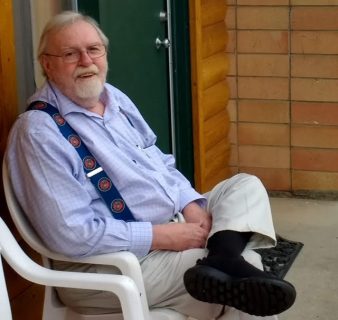History Mystery
Published 12:00 am Wednesday, December 20, 2000
For several years, in the early 1800s, the Rev. Joseph Lapsley looked over his flock at The Presbyterian Church in Bowling Green. In death, it appears he looked over an infant Joseph Underwood, who was born and died in 1833, and whose tiny, broken tombstone was pulled from the Lapsley family vault at Pioneer Cemetery on College Street in Bowling Green on Wednesday. Why those (pieces) were in that tomb, who knows? said Jonathan Jeffrey, a special collections librarian at Western Kentucky Universitys Kentucky Library and a member of the Landmark Association in Bowling Green. The Underwood childs tombstone was found recently when Nashville, Tenn., stonemason Graham Reed began making plans to repair the Lapsley vault, which was shattered last Valentines Day when a large tree crashed down on it during a thunderstorm. The vault was the only grave disturbed in the storm, but the citys insurance wouldnt cover the tree falling on it, said Jerre Fitts, an archivist for The Presbyterian Church, where Lapsley was the minister when it was founded in 1819.So, on Wednesday, the vault was being repaired under the direction of the church. Vernon White, a Bowling Green resident who is writing a book about grave covers, was excited about the restoration. Old cemeteries are certainly interesting in a variety of ways, he said. They represent our cultural heritage, and if theyre not likely to be redone, when they pass out of the picture, we dont know anything about them. Members of The Presbyterian Church arent going to let that happen to Joseph Lapsley, who came to Bowling Green from his native Rockbridge County in Virginia. According to Fitts, Lapsley passed away in Bowling Green in 1823 and was buried on his family farm, which sat on land where the Bowling Green-Warren County Regional Airport is now located. For many years, the grave site remained unchanged. But about 1863, Lapsleys body, and the bodies of two of his children, were moved to the vault at Pioneer Cemetery, which had held graves as early as 1811.No one seems to know exactly why the graves were moved, but Fitts said it is local lore that the Lapsley vault is located in the exact spot where Lapsleys pulpit stood before the church was torn down in 1831 so that its materials could be used to construct a new church, which is still in use, on State Street. Even more strange, no one knows how young Joseph Underwoods tombstone came to be smashed to bits inside the Lapsley vault. Jeffrey guessed that the broken stone was simply tossed into the vault during an early 20th century cleanup of the cemetery, which was once neglected and nearly covered with weeds. But, What I found interesting was that when the DAR (Daughters of the American Revolution) surveyed the cemetery in the 1940s, that name was not listed in their index, Jeffrey said of Joseph Underwood. Joseph Underwood was born to U.S. Sen. Joseph Rogers Underwood who built the home Ironwood, which is still used as a private residence in Warren County and Underwoods first wife, Eliza McCowes Trotter, who passed away in 1835, Jeffrey said. Joseph Underwood was the second child that the Underwoods named Joseph. The first child, named Joseph John Underwood, was born in 1825, according to Jeffrey. Many Underwood children who died during childhood are buried in Pioneer Cemetery, one of the oldest municipal cemeteries in the state, and the oldest cemetery in Bowling Green. According to the book Joseph B. Lapsley: From Rockbridge to Warren, by Fitts and fellow Presbyterian Church member Thomas Moody, Bowling Green founder Robert Moore in 1817 sold two lots to the city of Bowling Green, which used the land as a publick graveyard. But some Underwood children and Joseph Rogers Underwood are buried in Fairview Cemetery, considered the more fashionable cemetery at the times of their deaths, Jeffrey said. On Wednesday, Reed used his stonemason skills to patch together the remaining parts of Joseph Underwoods tombstone. It was not a job he had planned to encounter. Its a bit of a mystery, Fitts emphasized. Some parts of the tombstone may never be found, including the part that tells that little Joseph died the same year he was born. What is not a mystery is the fact that Lapsleys grave is an important monument for members of The Presbyterian Church. The Presbyterian Church has celebrated anniversaries there, Fitts said Friday. She described the 175th anniversary celebration in 1994, when about 200 parishioners marched, along with bagpipers, from the current Presbyterian Church on State Street to the Lapsley grave. At the grave, church members held Holy Communion. Its something they will likely do again when another big anniversary rolls around. And theyll be able to celebrate at a grave that is now no longer broken or cracked. Were obviously pleased to have it intact, Fitts said just before she went to the cemetery to remove plastic that Reed had placed over the vault until repairs set. Reed is glad he could restore the grave. My theory has always been Restore, not modernize, he said. Who wants to walk into a cemetery and look at a concrete top instead of a stone top? While Reed has used his skill which he acquired as a boy in his native Cambridge, England to build huge buildings, including the Humana Corporate Headquarters in Louisville, he best loves working to preserve history. He has helped to restore Tennessees Capitol building and The Hermitage, which was Andrew Jacksons Tennessee home. Graham recently helped to restore a Confederate cemetery in Franklin, Tenn. We enjoy doing this more than anything, Reed said as he worked alongside his 30-year-old son, Darren Reed. Restoration every time is a challenge.






